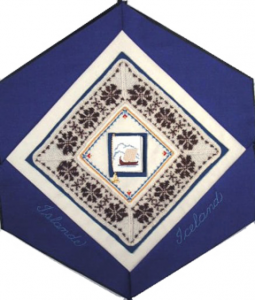Iceland

The Block
A three-dimensional, hand-embroidered book, symbolic of Icelanders’ respect for reading and learning, is the central element of the Iceland block, created by Shirley Ann Laxdal and Yolanda Gislason. The country’s literacy rate is 99.9 percent and there are more books, periodicals and newspapers published, bought and sold here per capita than anywhere else. Reflecting the island’s rich literary tradition (generally dominated by sagas, fact-based accounts of struggles, battles, heroics, religion and occupations), each ‘page’ tells its own story about the country and its people.
On the cover, a sailing ship symbolizes Icelanders’ adventurous spirit, and their landing and settling in Newfoundland a thousand years ago. Rippling waves denote the numerous lakes, rivers and waterfalls; silhouetted mountains stand for the many peaks, glaciers and volcanoes. A fish on ‘page one’ represents Iceland’s large fishing industry (upon which the island’s economy is based and which accounts for 70 percent of exports), and the cross on ‘page two’ celebrates over 1000 years of Christianity.
The hand-knitted border framing the book is typical of the patterns found in the country’s well-known sweaters. The traditional design is worked in Lopi wool, a unique, twin-fibre yarn made from the world’s longest-fleeced sheep. Knitting, an integral part of Icelandic culture for 400 years, continues to be an important skill today for both men and women. Children are taught the craft at a young age and many people throughout Iceland still spend their evenings and spare hours knitting such things as the popular yoke sweaters, mittens and caps.
Cultural Profile
Iceland, about twice the size of Nova Scotia, is a large island situated south of the Arctic Circle. It is part of the Mid-Atlantic Ridge and contains almost 200 volcanoes, at least one of which erupts every five years. Iceland is the site of more than 700 hot springs, which are an important source of central heating in many towns. The most famous is Geysir, from which the international word ‘geyser’ is derived. Another distinctive feature of the country is its glaciers, which cover more than eleven percent of the nation’s total area. In addition, the Icelandic Althing (established 930 A.D.) is the oldest functioning legislative assembly in the world. The population is a homogenous mixture of Norse and Celts, and the languages spoken are Icelandic (Old Norse), English and Danish.
Iceland has a strong cultural heritage and its people, who currently have the 3rd longest life expectancy in the world, have created a remarkable quality of life for themselves, despite the remote location of their island. Patronyms are a distinctive feature of Icelandic culture, where people receive a given name and use their father’s or mother’s given name as a last name suffixed with dòttir (‘daughter of’) or son (‘son of’).
Iceland’s music, both traditional and modern, is also an important part of its culture. Traditional instruments in Icelandic music include the langspil and the fiðlaI, both string instruments. Contemporary Icelandic music has achieved worldwide recognition with singers Björk and Emiliana Torrini or bands like Sigur Rós, GusGus and Of Monsters and Men. That this many prominent musicians would come from such a tiny place with such a small population, is an indicator of the vitality of Icelandic culture.
The country is also known for its spinning and weaving, pottery and glassware. The Icelandic sweater, the lopapeysa, is symbolic of arts and craft in the country. The knitted garment features a wide patterned yoke around the neck opening. Made of unspun wool, the fibers trap the air, resulting in a sweater that contains more air than actual yarn, making it extremely warm. The famous Icelandic horse, at one time the only means of transportation on the island, is now used mainly for leisure and competition. All horses found in Iceland today are descendants of those brought to the island by the Vikings. Abiding by an ancient Viking law that is still upheld today, no other breeds are allowed into the country and any horse that leaves can never return.
Icelanders, coming by way of Greenland, were the first European visitors to what is now Canada and archaeological excavations at L’Anse aux Meadows indicate that the Norse settled in Newfoundland in the tenth century. The first recorded Icelander to land in Canada since then was Sigtryggur Jonasson, who arrived in Québec City in 1872. By 1875 a unique political structure in Canadian history had been established––New Iceland––the main settlement of which was Gimli (named for the ‘Hall of Gimli,’ known in Norse mythology as paradise). Settlers created their own laws, maintained their own schools, developed a fishing industry and for years managed their own affairs, until the reserve became part of Manitoba.
Icelanders continued to immigrate to Canada over the years, creating settlements in Ontario, Saskatchewan and Alberta. In 2011, 94,000 Canadians were of Icelandic ancestry, making this the largest Icelandic population outside of Iceland. They have contributed to Canadian society in a number of areas, in particular medicine, law and education. Associations, including the Icelandic National League of North America and the Icelandic Canadian Club have been established, and celebrations like Winnipeg’s annual Islendingadagurinn (Icelandic Festival to honour the Icelandic pioneers of Canada) allow Icelanders to share their culture with other Canadians.
Sponsor: Vatnabyggd Icelandic Club of Saskatchewan Inc.
